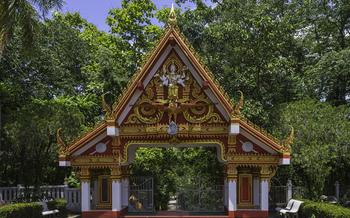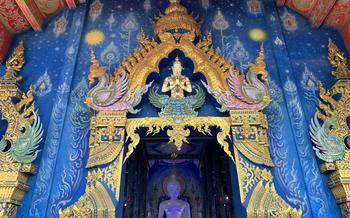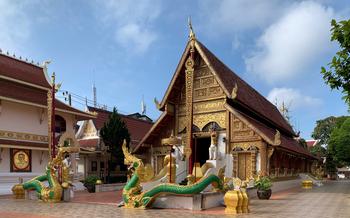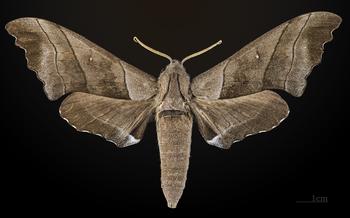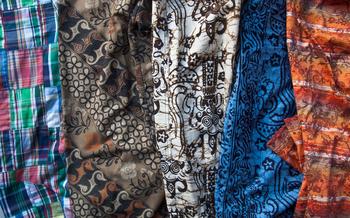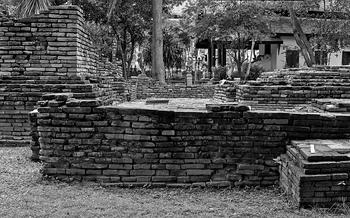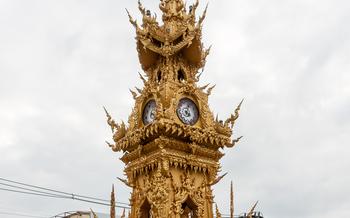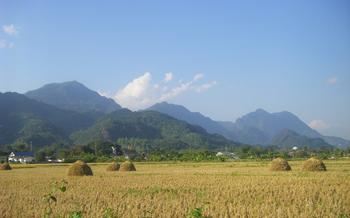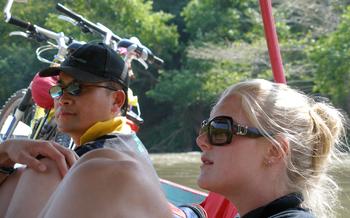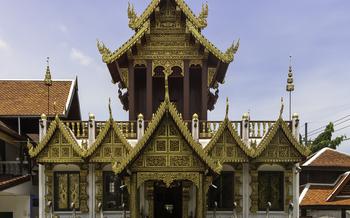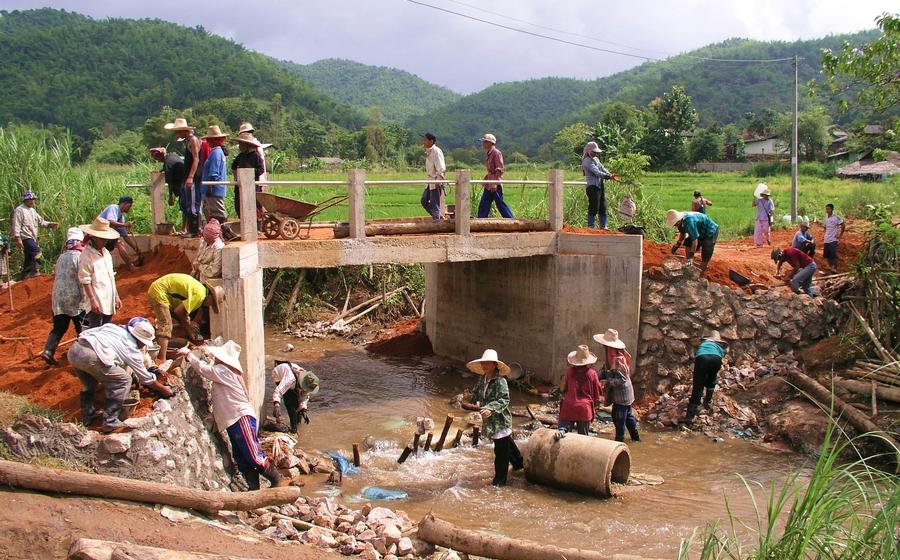
Chiang Rai Rajabhat University Cultural Museum
- Location and Accessibility:
- Museum Timings and Admission Fees:
- Architectural Significance:
- Museum Layout and Exhibits
- Cultural Artifacts and Collections:
- Interactive Displays and Activities:
- Educational Programs and Workshops:
- Guided Tours Availability
- Temporary Exhibitions and Events
- Research Facilities and Publications
- Accessibility for Visitors with Disabilities
- Photography and Social Media Policy
- Insider Tip:
Location and Accessibility:
The Chiang Rai Rajabhat University Cultural Museum is conveniently situated at 110 Moo 17, Mae Fah Lu the scenic Mae Fah Luang campus, surrounded by lush greenery and tranquil surroundings. Visitors can easily access the museum by taking a short drive or ride from the city center, approximately 10 kilometers away. Public transportation options are also available, with local buses and songthaews (shared taxis) stopping nearby. For those seeking a more immersive experience, renting a bicycle or motorbike is a great way to explore the scenic countryside while en route to the museum.
Museum Timings and Admission Fees:
The Chiang Rai Rajabhat University Cultural Museum welcomes visitors from Tuesday to Sunday, with its doors remaining closed on Mondays. The museum's operating hours are from 9:00 AM to 4:00 PM, providing ample time to explore the diverse exhibits.
Admission fees are quite reasonable, ensuring that everyone has the opportunity to immerse themselves in the cultural heritage of the region. Adults are charged a modest fee of 100 Thai Baht, while students and children can enjoy discounted rates of 50 Thai Baht. The museum also offers special offers and packages for groups or families, making it an affordable and enjoyable experience for all.
Architectural Significance:
The Chiang Rai Rajabhat University Cultural Museum stands as a testament to the region's rich architectural heritage. Its striking design is a blend of traditional Thai and Lanna architectural elements, creating a unique and visually appealing structure. The museum's exterior features intricate carvings, gabled roofs, and a vibrant color palette, reflecting the vibrant culture and artistry of the region.
The building's design draws inspiration from traditional Lanna architecture, which emphasizes the use of natural materials and open spaces. The museum's layout and orientation allow for ample natural light to flood the interior, creating a bright and airy atmosphere. The use of wood and other local materials adds to the building's authenticity and connection to the surrounding environment.
One notable feature of the museum's architecture is its central courtyard, which serves as a focal point for visitors. The courtyard is surrounded by covered walkways and features a serene pond, creating a tranquil and contemplative space. This design element is characteristic of traditional Thai architecture, where courtyards were often used to provide natural ventilation and a sense of openness.
Overall, the architectural significance of the Chiang Rai Rajabhat University Cultural Museum lies in its harmonious blend of traditional and modern elements, which showcase the region's cultural heritage while providing a functional and inviting space for visitors to explore and learn.
Museum Layout and Exhibits
The Chiang Rai Rajabhat University Cultural Museum is organized into several sections, each showcasing different aspects of the region's rich history and culture. The "Archaeological Gallery" displays artifacts excavated from nearby archaeological sites, offering a glimpse into the ancient civilizations that once thrived in the area. The "Historical Gallery" features exhibits on the history of Chiang Rai, from its early settlement to its role as a significant trading center in the Lanna Kingdom.
The "Ethnographic Gallery" showcases the diverse ethnic groups that make up the region, highlighting their unique traditions, customs, and lifestyles. Visitors can learn about the intricate textiles, traditional musical instruments, and everyday objects used by these communities. The "Art Gallery" displays a collection of contemporary and traditional artwork from local artists, providing a platform for local talent and promoting cultural exchange.
Cultural Artifacts and Collections:
The Chiang Rai Rajabhat University Cultural Museum houses an extensive collection of cultural artifacts that provide a profound glimpse into the history and traditions of the region. These artifacts cover a diverse range of categories, from ancient pottery and sculptures to traditional textiles and musical instruments. One of the highlights of the collection is the exquisite collection of Lanna ceramics, which showcases the unique and vibrant artistic style of the Lanna Kingdom. Visitors can also marvel at the intricate silver and gold jewelry, which reflects the region's rich craftsmanship and artistry. The museum also boasts a collection of ancient manuscripts and religious texts, offering valuable insights into the spiritual and philosophical traditions of the region. These artifacts, meticulously preserved and displayed, narrate the captivating story of Chiang Rai's cultural heritage, inviting visitors to delve into the depths of its rich past.
Interactive Displays and Activities:
The Chiang Rai Rajabhat University Cultural Museum provides an enriching and engaging experience through its interactive exhibits and activities. Visitors can immerse themselves in the cultural heritage of the region through hands-on displays that bring the past to life. Interactive touchscreens offer detailed information about the artifacts and allow visitors to explore the history of Chiang Rai at their own pace. Virtual reality and augmented reality experiences transport visitors to different eras and provide a multisensory journey through the museum's collection. These interactive elements enhance the visitor experience by creating a deeper connection with the cultural artifacts and allowing visitors to engage with the museum's content in a dynamic and memorable way.
One of the highlights of the museum's interactive displays is a virtual reality tour of the ancient city of Wiang Kum Kam, which offers a glimpse into the life and culture of the city during its heyday. Visitors can explore the ruins, interact with virtual characters, and learn about the city's history and significance. Another interactive exhibit allows visitors to try their hand at traditional Thai musical instruments, such as the khene, ranat, and khaen, providing an opportunity to engage with and appreciate the region's musical heritage.
Educational Programs and Workshops:
The Chiang Rai Rajabhat University Cultural Museum extends its educational mission beyond its static exhibits through a diverse range of educational programs and workshops. These programs are designed to cater to various audiences, including students, researchers, and the general public.
Weekly lectures and seminars are organized, featuring renowned scholars and experts in the fields of archaeology, history, and cultural studies. These sessions provide in-depth insights into specific aspects of Thai culture and history, allowing participants to delve deeper into the region's rich heritage.
The museum also conducts hands-on workshops, inviting participants to engage actively with the museum's artifacts and collections. These workshops may focus on traditional crafts, such as pottery or textile weaving, or on archaeological techniques, such as excavation and artifact conservation.
For those seeking a more immersive educational experience, the museum offers specialized courses and workshops that run for several weeks or months. These courses cover a wide range of topics, from the history of Lanna to the interpretation of archaeological data.
By participating in these educational programs and workshops, visitors can not only gain a deeper understanding of Thai culture and history but also contribute to the preservation and promotion of this region's unique heritage.
Guided Tours Availability
The Chiang Rai Rajabhat University Cultural Museum offers guided tours in both Thai and English to enhance the visitor experience. These tours are led by knowledgeable guides who provide insights into the cultural significance of the artifacts and the history of the region. Guided tours typically cost around 200 baht per person and last for approximately one hour.
Taking a guided tour is highly recommended, especially for first-time visitors or those interested in learning more about the cultural heritage of Chiang Rai. The guides can provide personalized explanations, answer questions, and share interesting anecdotes that bring the exhibits to life. Visitors can book guided tours in advance through the museum's website or by contacting the museum directly.
Temporary Exhibitions and Events
The Chiang Rai Rajabhat University Cultural Museum often hosts temporary exhibitions and special events to showcase diverse aspects of regional culture and history. These exhibitions are a great way to experience unique collections and themes beyond the permanent displays. In the past, the museum has organized exhibitions on topics such as traditional textiles, local handicrafts, contemporary art, and historical photographs.
Special events and workshops are also organized periodically, providing visitors with an opportunity to engage with experts and participate in hands-on activities. These events may include cultural performances, demonstrations, workshops on traditional crafts, and educational talks. Visitors are encouraged to check the museum's website or social media channels for information on upcoming exhibitions and events to plan their visit accordingly.
Research Facilities and Publications
The Chiang Rai Rajabhat University Cultural Museum is not just a repository of artifacts; it is also a vibrant hub of research and scholarship. The museum boasts a dedicated team of researchers and scholars who are actively engaged in studying and documenting the cultural heritage of the region. Their work contributes significantly to the understanding and preservation of local traditions, customs, and history.
The museum's research facilities include a well-equipped library, archives, and conservation laboratory. These resources support the research activities of the museum staff and visiting scholars. The library houses a vast collection of books, journals, and manuscripts related to the region's history, culture, and archaeology. The archives contain a wealth of primary source materials, such as photographs, documents, and oral histories. The conservation laboratory is equipped with state-of-the-art technology for the preservation and restoration of artifacts.
The museum actively publishes research findings and scholarly works. It produces a regular journal, "Chiang Rai Cultural Studies," which features articles on various aspects of the region's culture and history. The museum also publishes books, monographs, and exhibition catalogs that showcase the results of its research projects. These publications are widely disseminated to scholars, students, and the general public, contributing to the dissemination of knowledge and understanding of the region's cultural heritage.
Accessibility for Visitors with Disabilities
The Chiang Rai Rajabhat University Cultural Museum recognizes the importance of accessibility for visitors with disabilities. The museum is committed to providing an inclusive and welcoming environment for all visitors regardless of their physical abilities. The museum features wheelchair-accessible ramps and elevators that allow visitors to navigate the different levels of the building with ease. Additionally, the museum provides wheelchairs for visitors who may require assistance in getting around the galleries. The museum staff is trained to assist visitors with disabilities and can provide information and directions in a sensitive and understanding manner. The museum's website also provides accessibility information to help visitors plan their visit in advance.
Photography and Social Media Policy
The Chiang Rai Rajabhat University Cultural Museum encourages visitors to capture and share their experiences through photography and social media. Visitors are permitted to take photographs and videos for personal use, provided that they do not use flash photography or tripods. The museum requests that visitors respect the privacy of other visitors and refrain from taking photographs or videos of individuals without their consent.
Visitors are welcome to share their photos and videos on social media platforms, using the hashtag #CRRMuseum. By sharing their experiences, visitors can help promote the museum and its mission to preserve and showcase the cultural heritage of the region.
Insider Tip:
For an unforgettable experience, plan your visit during the annual Chiang Rai Flower Festival, held in February. The museum grounds transform into a vibrant tapestry of colors as flowers of all varieties bloom in profusion. Take advantage of the opportunity to witness the stunning floral displays while exploring the museum's cultural treasures. The festival offers a unique blend of art, nature, and local traditions, making it an ideal time to immerse yourself in the cultural heritage of Chiang Rai.
